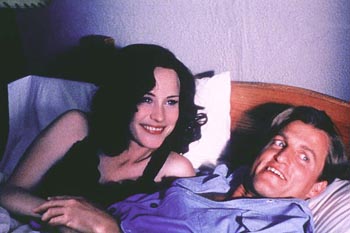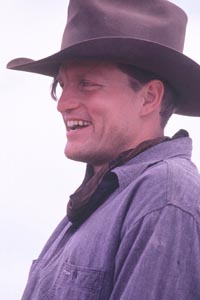![[Metroactive Movies]](http://metroactive.com/movies/gifs/movies468.gif)
[ Movies Index | Metro Santa Cruz | Metroactive Central | Archives ]
How the West Was Wayne
 Cowpoke: Woody Harrelson beds the foreman's wife (Patricia Arquette) in 'The Hi-Lo Country.' Stephen Frears' 'The Hi-Lo Country' redeems the Western myth in all its troubling complexity HOW DO YOU make a John Wayne movie at this late date in movie history? In an interview, Stephen Frears, director of the first good Western in years, The Hi-Lo Country, tells me that making a Western "is like making a film about Martians.... When you look at [cowboys with] these extraordinary costumes and rituals--and, well, life ain't like that anymore. And you can see that kids don't have cowboys as their heroes." Space operas have replaced cowboy dramas. In the Star Wars trilogy, good fights evil--and evil is disfigured and breathes funny so you can tell the difference. But Frears' advice to lead actor Woody Harrelson was simple: Be John Wayne. Wayne, however, is not so simple a model; he's a sticky subject, as befits a heartbreaker. John Wayne was anathema in my house when I was growing up. If one of his movies was playing on television, my mom switched it off. Southern Californians--or my mom, at least--knew too well about Wayne's troglodyte politics. It was only when I left California to visit my grandparents that I got a good look at him. On the train to Seminole, Okla., I avidly read Charles Portis' novel True Grit and anticipated the movie version. When it was released a few months later, I saw Wayne for what felt like the first time: one-eyed, paunchy, loping and profane. My grandfather, who loved the Duke, made sure we caught every late-period Wayne movie that played at the Starlight Drive-In: Chisum, The War Wagon, Rio Lobo. That was the old Wayne--Lionel Barrymore without the wheelchair. Understanding what Wayne used to mean was something I discovered later in life, at revivals of The Searchers, Stagecoach and Red River. Even now I tend to see Wayne's virtues secondhand, through the reminiscences of other writers. Joan Didion, in The White Album, still cherishes a line from 1947's Angel and the Badman about Wayne planning to build his lady a house in the bend in the river where the cottonwoods grow. Gary Willis' recent book on Wayne is full of smoldering love, but it reveals the inevitable--in real life, Wayne dodged the draft and hated horses. Willis and Didion are middle-aged moviegoers recalling a Wayne they'd seen long ago. When the young men in last year's Smoke Signals sang a naughty song about John Wayne's teeth, how I wished that some 5-year-old in the audience had exploded the conceit by piping up, "Who's John Wayne, Mommy?" The Vietnam War, that great American moment of cognitive dissonance, filled the Western genre plumb full of lead. Wayne, like Bob Hope, lost his younger audience because he supported the war. The studios preferred not to address Vietnam directly, and so they made Westerns in which Vietnam was addressed symbolically, with lots of atrocities against the Indians. Naturally, these films were hated and are forgotten now. More recently, there have been attempts to make authentic Westerns with the bigger-than-life violence of Stallone and Willis movies. As someone--soft-core king Russ Meyer, I think--once said, the Western was doomed to extinction because six-guns don't have as big a bang as assault rifles.
Richard von Busack interviews Frears about his latest film.
AGAINST the background of a fatally ill genre, The Hi-Lo Country does what wouldn't seem to be possible: it revives a myth, but cautiously. Harrelson plays Big Boy Matson, the hero, a Marine vet of World War II. He has returned to the New Mexico hills, ready to punch cattle. The land, however, has been bought by a war profiteer, Jim Ed Love (Sam Elliott, playing a cowboy Satan to match his cowboy angel in The Big Lebowski). Matson and his partner, Pete Calder (Billy Crudup), do their best to hang on to the dying occupation of punching cattle. Meanwhile, Matson commences an affair with the straying wife, Mona Birk (Patricia Arquette), of Love's foreman. Pete kissed Mona once and still has a yearning for the married woman. Matson, fearing no man, doesn't care who knows about his affair. Pete's weakness--his fear of Big Boy's disfavor and his violent streak--keeps him from telling Big Boy about his own feelings for Mona. The forked quality of The Hi-Lo Country has thrown off reviewers: The film understands the nobility of the old Western virtue of keeping your mouth shut, and yet it's wise to the terrible misunderstandings that can arise because of silence. The surprise is how big the film is. You don't expect an epic, and it sneaks up on you--a too long epic, yes; the final fistfight is one fistfight too many. But the big skies and Carter Burwell's Elmer Bernstein-style score bring back the memories of the best Westerns, and The Hi-Lo Country doesn't suffer by comparison the memories. A rodeo sequence is so dangerous-looking that you'll wonder how the director pulled it off, and there's a minor classic of a high-stakes poker game with a villainous banker (Lane Smith). Walon Green, who wrote The Wild Bunch, has a way with tough-talking cowpokes; although the narration is sometimes self-consciously fancy, the dialogue is crisp and understated. One example: as a small-time rancher, James Gammon has a good, tough line after a fall from his horse: "Something's broke inside, boys. I can feel the pieces movin'." The Hi-Lo Country is directed by an Englishman, Stephen Frears (My Beautiful Laundrette, The Grifters), and he challenges many of the myths of the West. There are those who can't watch a John Wayne film without mixed emotions, and Frears' reservations about Wayne's persona give this movie a conflicted mood. The film has undertones about the sense of loss that comes from not being good enough. Pete's own weakness poisons his conscience, and Big Boy's goading of his weakling brother, Little Boy (Cole Hauser), turns out to be his undoing.
Harrelson understands John Wayne perfectly, on what looks like a pre-verbal level. Leaning back and resting his long arms against a bar, the loose-limbed and open-handed Harrelson is every inch a movie cowboy. He appears to be a foot taller than anyone else in The Hi-Lo Country. What Harrelson shows us is that Big Boy is also a bully who enjoys putting the hurt into his enemies. We learn to accept that negative quality as part of our admiration for his bigness--just as appreciating Wayne means shoving to the back of one's mind the fact that the man often played bullies. (Frears quotes Godard to me: "How can I love John Wayne and hate his politics?") By showing how Big Boy likes to turn the screws on the people who get in his way, Frears rouses mixed feelings about power fantasies--thoughts about why Wayne is who he is, and why you're not. The Hi-Lo Country isn't about being John Wayne, it's about watching John Wayne. Living in a city, how can any man make thought, word and deed all function as one? That sort of unity of purpose is only found in movie cowboys. Or in sociopaths. Harrelson shows us that a good cowboy has a lot of madman in him. The Hi-Lo Country is a critique, not a debunking. At the end, the film resonates with the mythic heroism and generosity that Wayne at his best embodied. An ad for one of old-time cowboy star William S. Hart's movies claimed: "His movies make folks breathe easier." For me, that's the emotion The Hi-Lo Country evokes. It is a reconciliation of divided feelings for the great cowboy star, making the old movie myth once again--to use a degraded word--inspirational.
The Hi-Lo Country (R; 114 min.), directed by Stephen Frears, written by Walon Green, based on the book by Max Evans, photographed by Oliver Stapleton and starring Woody Harrelson, Billy Crudup and Patricia Arquette. [ San Jose | Metroactive Central | Archives ]
|
From the January 21-27, 1999 issue of Metro.
Copyright © Metro Publishing Inc. Maintained by Boulevards New Media.
![[line]](/gifs/line.gif)
 Big Boy Bully: Woody Harrelson understands John Wayne perfectly.
Big Boy Bully: Woody Harrelson understands John Wayne perfectly.